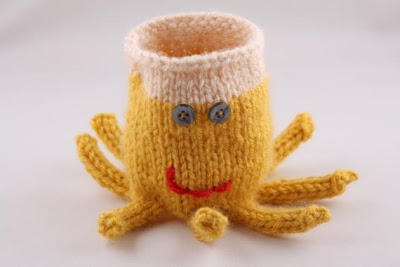I recently spoke at my monthly guild meeting on the topic of why we knit. Part of my presentation looked briefly at the different types of Knitters out there. A member of the audience has asked me to expand on my thoughts and while I started to make some notes I got a little silly thinking about how I would present this information. What follows is Part 1 of my light-hearted take on the various categories of Knitters that I have met in the knitting world.
Sock Knitters (Pes pedis knitcreo)
Description
Appearances vary greatly among sock knitters. Many start with only one pair and then are unable to stop producing. Toe up and cuff down variations occur frequently. There have been a few rare sightings of the side to side variety. Heel construction varies from traditional short rows to afterthought versions and new ones continue to be developed. They are highly competitive, often setting specific time limits to reach completion. They claim to never experience cold feet. The dreaded second sock syndrome threatens the population.
Habitat and range
They are found throughout the world. Several were recently spotted at the Fox and Fiddle on Bloor Street on the evening that the Downtown Knit Collective meets. One was observed, perched shoeless on the edge of her chair to show off a delightful pair of identically matched striped socks. Many groups exist on Ravelry (94 at the last count). Especially large numbers congregate at Sock Summit biannually. A more recent sighting occurred at the Bata Shoe Museum.
Vocalizations
Their calls often include words like double pointed needles vs. magic loop. They have a strong preference for either identical or fraternal offspring based on whether they are left or right brained. What to do about the wearing out of socks, is frequently discussed with many variations preferred as to yarn fibre preference, gauge, darning vs. weaving and grafting techniques.
Academic Knitters (Erudio knitcreo)
Description
This species of Knitters typically documents past Knitting traditions. They have little interest in new techniques or variations in approach. They care deeply about maintaining and protecting information about their specific area of expertise. If they step outside of documentation into design it's with a clear mandate to work only with traditional methods and to supply a more modern interpretation to keep the traditions alive. A small subcategory exists; usually found at Universities. This subspecies studies the Knitters themselves, mapping brainwaves, studying the peaks and drops of blood pressure and analyzing the impact of knitting on memory.
Habitat and range
They are found throughout the world. Most frequently they are seen at institutions of higher learning, libraries and museums. One spent a great deal of time in the Estonian section of the Royal Ontario Museum a number of years ago and recently another made appearances at the Museum for Textiles in Toronto.
Vocalizations
Their calls often include words like heritage and traditions. Often they focus on specific technical areas of knitting or geographical/national origins. Many are teachers who share their vast knowledge of their specific area of study with others.Extended vocalizations exist in written form mainly in books and often in Piecework magazine.
Check back for future postings that will expand this guide.























